Everything you need to know about Crypto Loans
By Figure Markets Research Group
July 10, 2024

The world of crypto is constantly evolving, going far beyond just buying and selling digital assets. One exciting development is the rise of crypto loans, also known as cryptocurrency loans.
With a crypto loan, you can borrow a traditional currency (like USD or EUR) or a stablecoin (like USDC) by using your cryptocurrency as collateral just like you would use other assets - like a house or a car.
This concept brings more flexibility and a unique opportunity to leverage existing crypto assets to secure financing. But how exactly do crypto loans work? What are the benefits and risks involved? And how do crypto loans compare to traditional loans?
Whether you’re a seasoned crypto user or just exploring the possibilities, this guide will help you understand everything you need to know about how crypto loans work.
Want to explore the world of crypto-backed loans at your own pace? Download the Ultimate Guide to Crypto-Backed Loans and read it later.
What is a crypto loan?
Navigating the world of crypto lending can feel like wading through a sea of jargon and technical terms. But don’t worry—we’re here to help. Here’s a breakdown of the most common terms you’ll encounter, making it simple and straightforward for you to understand how crypto loans work.
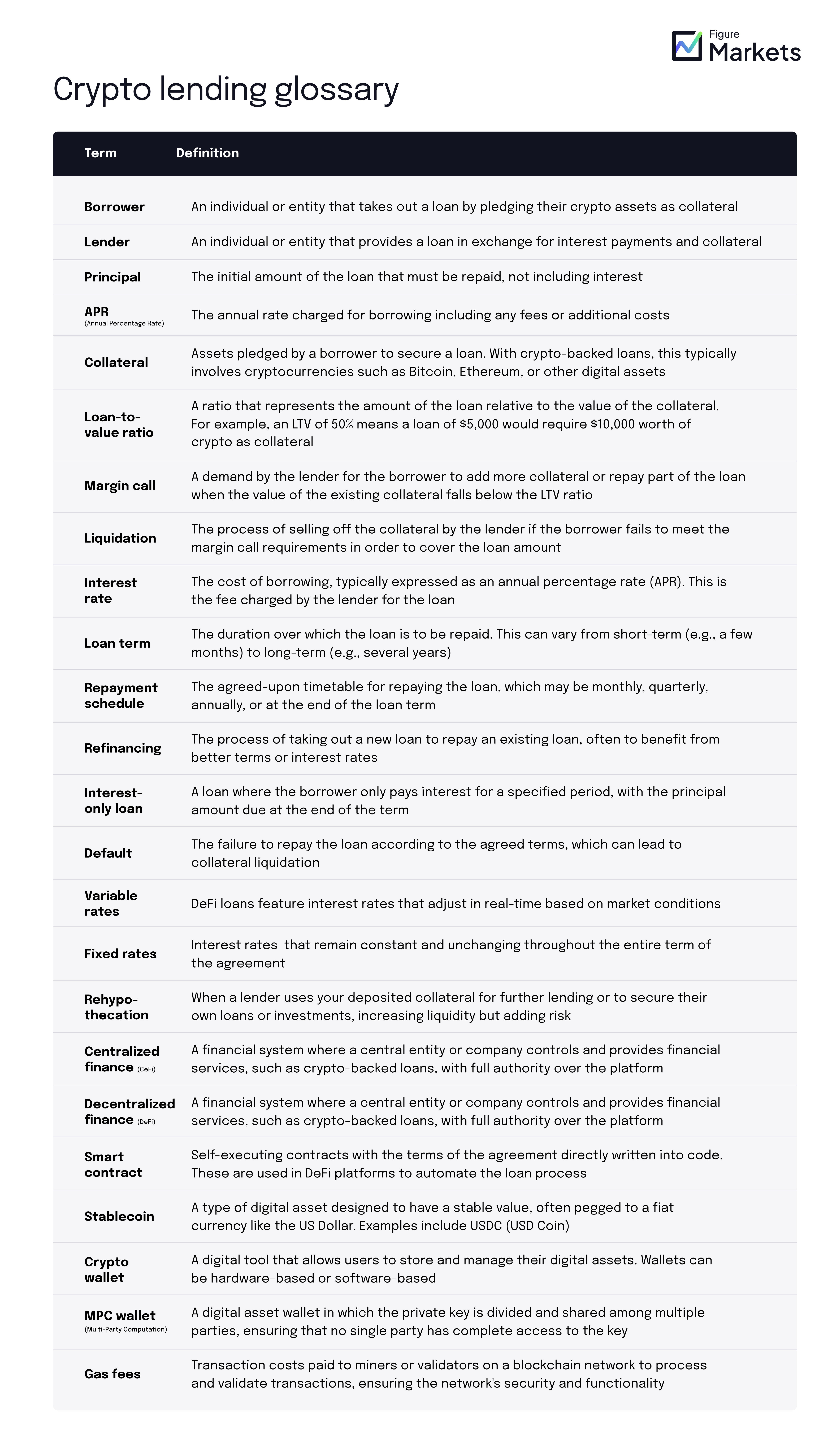
Now that you’ve familiarized yourself with the most common crypto lending terms, let’s understand what crypto-backed loans are and how they work.
A crypto loan is a type of secured loan in which you pledge digital assets as collateral to receive a loan in fiat currency (e.g. USD, EUR, BRL) or stablecoins (e.g. USDC, USDT). It’s similar to a traditional secured loan, like a mortgage or a car loan, in which the asset acts as a security for the lender.
How are crypto loans different from traditional loans?
Unlike traditional loans that typically require credit checks and extensive paperwork, crypto loans offer a more streamlined and accessible lending process:
- No credit checks: Crypto-backed loans do not require credit checks. The collateral itself reduces the lender’s risk.
- Faster approval: The process is usually fast and straightforward, with funds often available quickly.
- Transparency: Some crypto loans leverage blockchain technology, offering a decentralized and transparent process that eliminates many of the inefficiencies of conventional banking systems.
- Tax benefits: Crypto-backed loans may provide some borrowers with certain tax benefits.
Types of crypto loans
There are two types of cryptocurrency loans: CeFi and DeFi.
Centralized finance (CeFi) loans are crypto loans offered by centralized institutions or platforms. Similar to traditional loans, they may be easier to use but require trusting a central entity with your crypto.
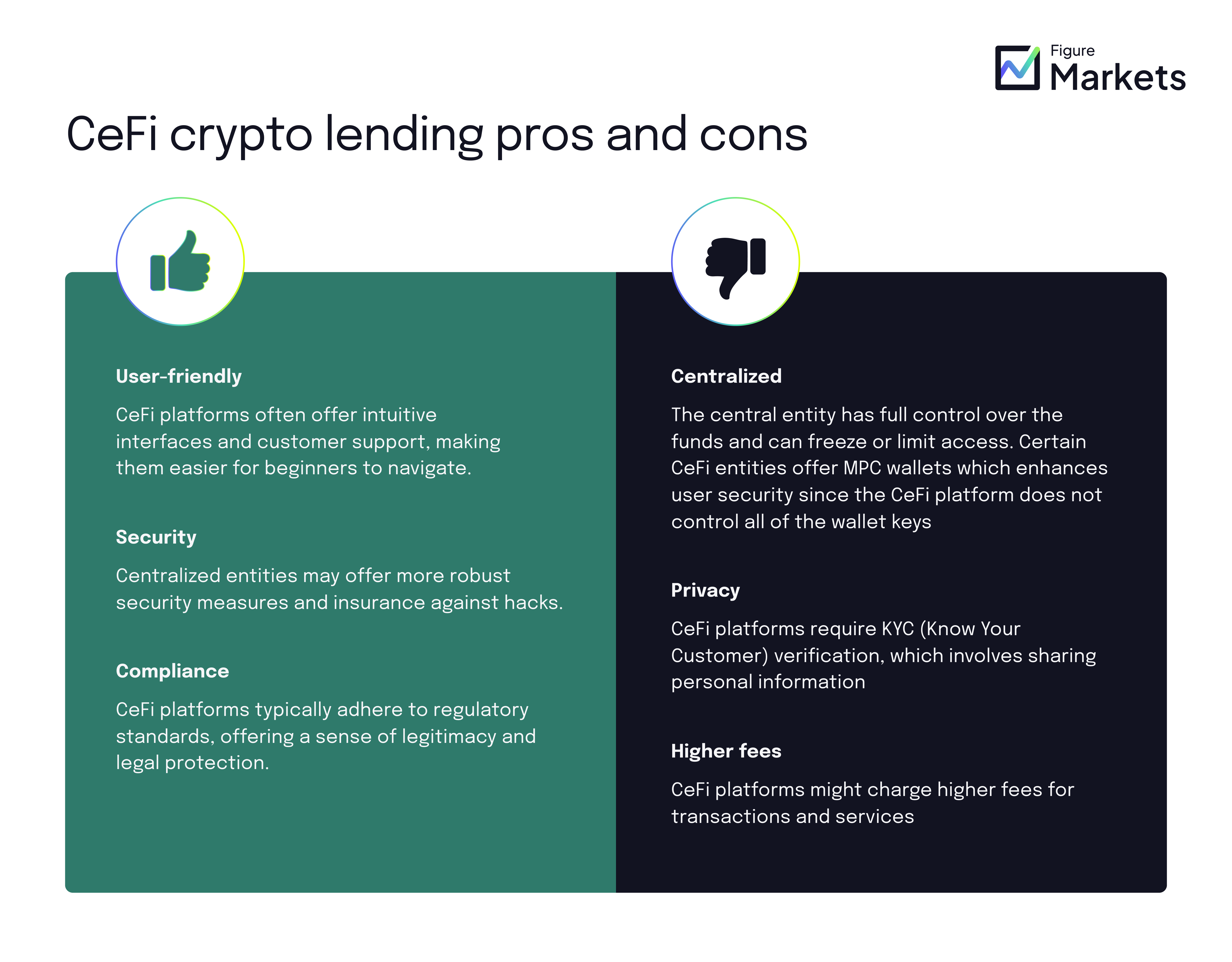
Decentralized finance (DeFi) loans are cryptocurrency loans managed by smart contracts on a blockchain network, which means no intermediaries. They offer greater transparency, accessibility and, often, lower fees, but come with higher risk and complexity.
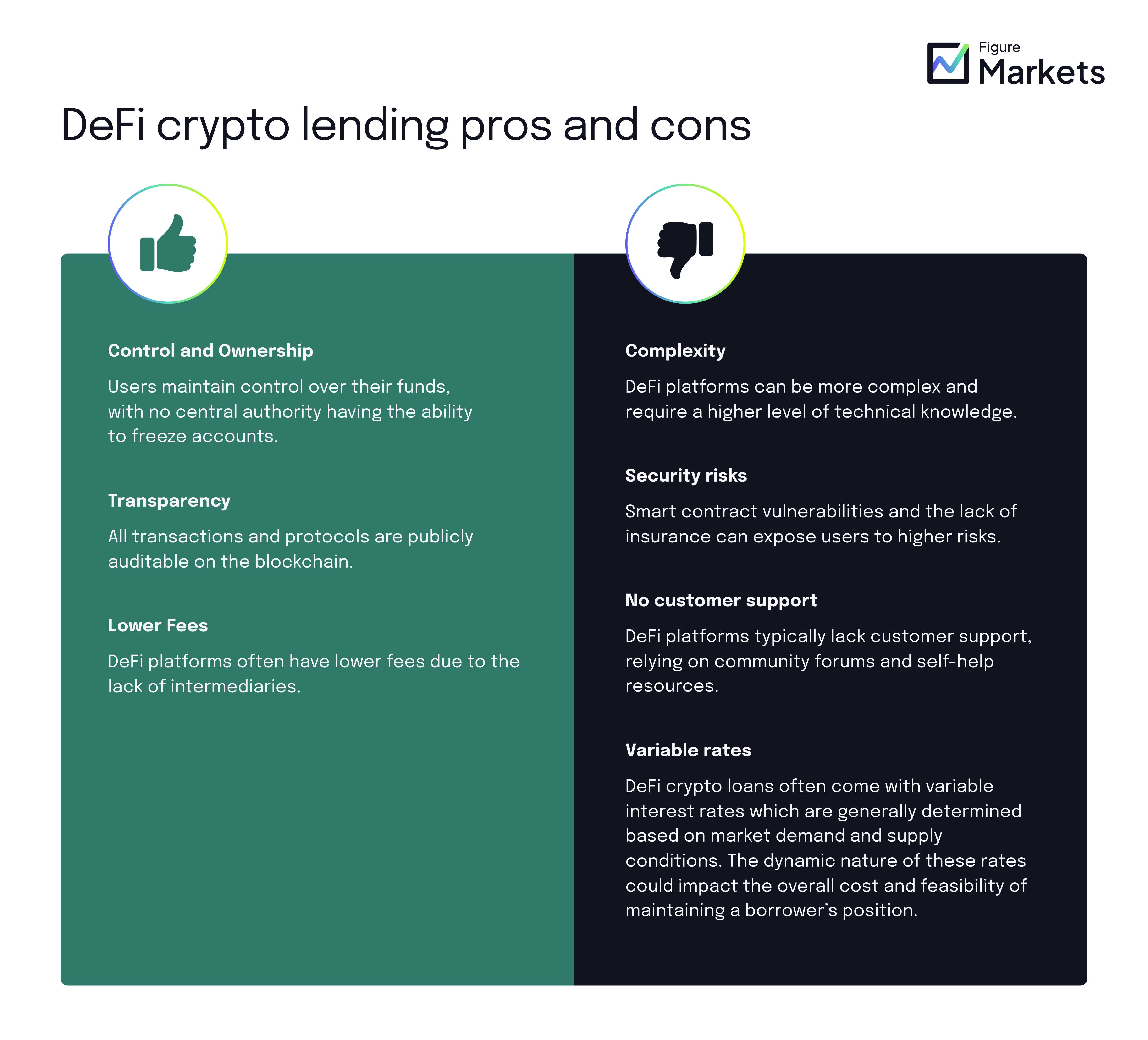
Choosing between CeFi and DeFi for crypto loans depends on your preference. CeFi offers ease of use, compliance, and customer support, but at the cost of higher fees and less control. DeFi provides greater control, transparency, and potentially lower fees, but requires technical know-how and carries higher security risks.
How to get a crypto loan
There are many ways to take out a crypto-backed loan, each offering unique advantages to suit different needs. You can choose centralized finance (CeFi) platforms for straightforward, secure loans, or explore decentralized finance (DeFi) options for greater control but require greater technical knowledge to use.
Here’s a general overview on how to take out loans on each type of platform. For more specifics, please refer to the specific platform’s instructions on their respective websites.
How to get a crypto loan on a CeFi lending platform
Step 1: Create an account on a CeFi platform
Step 2: Send collateral
Step 3: Borrow funds
How to get a crypto loan on a DeFi lending platform
Step 1: Set up a crypto wallet
Step 2. Install and configure wallet
Step 3: Transfer the crypto assets you plan to use as collateral to your wallet
Step 4: Connect to DeFi lending platform
Step 5: Deposit collateral
Step 6: Borrow Funds
Loan monitoring
Taking out a DeFi crypto loan generally requires more constant monitoring compared to CeFi loans due to the nature of smart contracts.
In DeFi, smart contracts are programmed to automatically liquidate collateral if certain conditions, such as a LTV ratio, are met. This automation ensures prompt action but also means that borrowers must vigilantly track the value of their collateral and market conditions to avoid sudden liquidation.
Unlike CeFi crypto loans, where there might be more flexibility and time to respond to margin calls, DeFi loans generally offer no such leniency, making continuous monitoring essential to manage the risk of automatic liquidation effectively.
Interest rates
DeFi crypto loans often come with variable interest rates, which are generally determined based on market demand and supply conditions.
Unlike traditional loans with fixed rates, DeFi loan rates are determined by algorithms within smart contracts that adjust in real time. This variability can lead to opportunities for lower interest payments during periods of high liquidity but also carries the risk of rising rates during times of increased borrowing demand.
You must be aware of these fluctuations and manage your loans accordingly, as the dynamic nature of DeFi interest rates can impact the overall cost and feasibility of maintaining your positions.
Taking it all in? Download the Ultimate Guide to Crypto-Backed Loans and have it at your fingertips for future reference.
Crypto loans and margin calls
One critical aspect of crypto loans is the risk of margin calls. If the value of your crypto collateral drops significantly, the lender may issue a margin call and require you to deposit additional collateral to maintain the agreed LTV ratio. If you fail to do so, they might liquidate your collateral to cover the loan.
Not all lenders issue margin calls, and in some cases, collateral may be automatically liquidated.
What happens to my loan if my crypto collateral goes down in value?
Consider a scenario in which you take out a $10,000 loan backed by 1 Bitcoin (BTC) as collateral. At the time of the loan, the price of Bitcoin is $30,000, resulting in an initial Loan-to-Value (LTV) ratio of 33.33%. This is calculated by dividing the loan amount by the value of the collateral and multiplying by 100.
However, if the price of Bitcoin falls to $20,000, the value of your collateral decreases to $20,000. Consequently, the LTV ratio increases to 50%, as the loan amount remains the same while the value of the collateral has dropped. This new LTV ratio is also calculated by dividing the loan amount by the new value of the collateral and multiplying by 100.
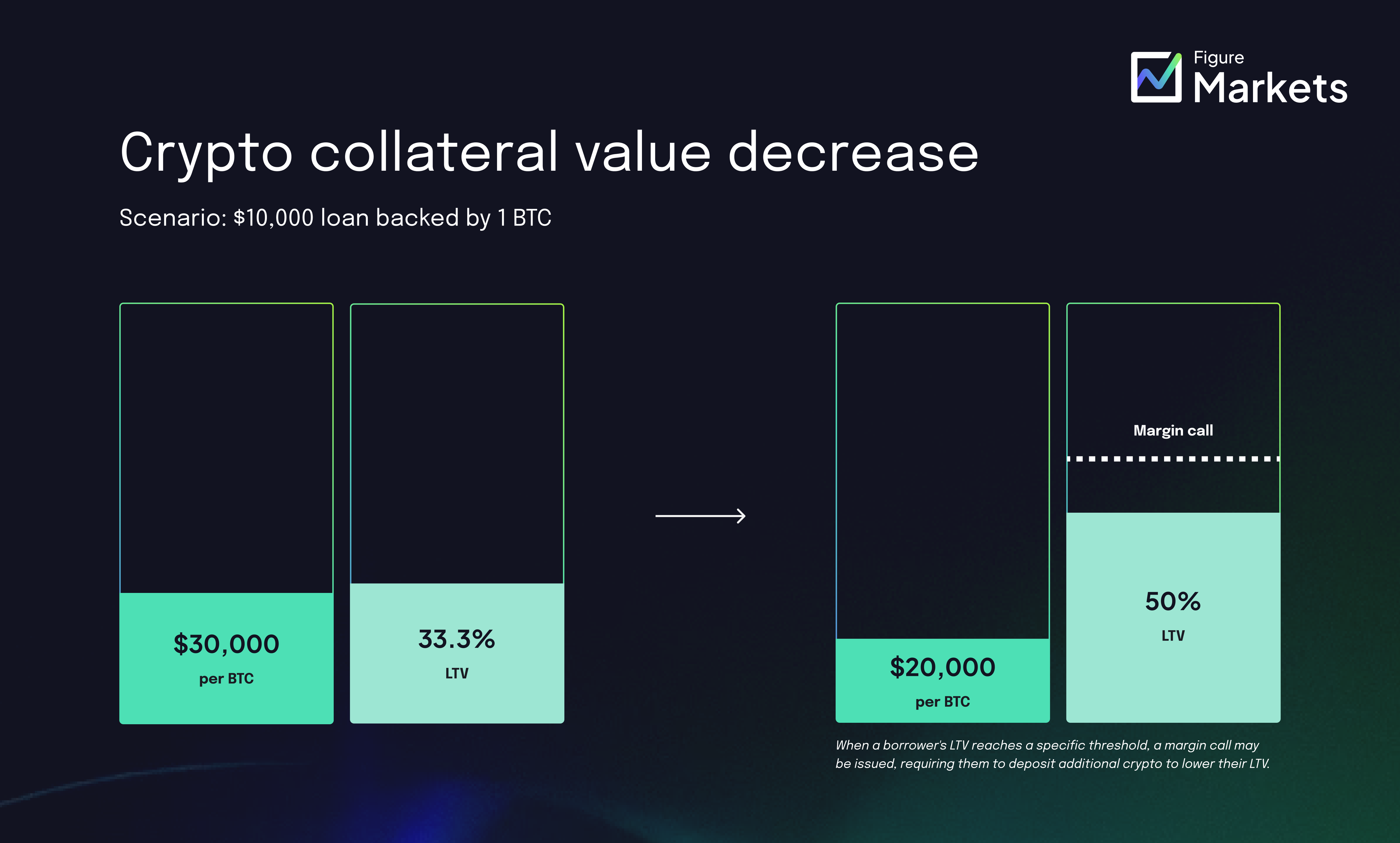
An increase in the LTV ratio indicates higher risk for the lender because the collateral is now worth less relative to the loan amount. If the LTV ratio exceeds a certain threshold, such as 70-80%, the lender may issue a margin call, requiring you to add more collateral or repay part of the loan. Failure to meet the margin call could result in the lender liquidating your collateral to cover the loan.
What happens to my loan if my crypto collateral goes up in value?
Consider a scenario in which you take out a $10,000 loan backed by 1 Bitcoin (BTC) as collateral. At the time of the loan, the price of Bitcoin is $30,000, resulting in an initial Loan-to-Value (LTV) ratio of 33.33%. This is calculated by dividing the loan amount by the value of the collateral and multiplying by 100.
However, if the price of Bitcoin rises to $50,000, the value of your collateral increases to $50,000. Consequently, the LTV ratio decreases to 20%, as the loan amount remains the same while the value of the collateral has increased. This new LTV ratio is also calculated by dividing the loan amount by the new value of the collateral and multiplying by 100.
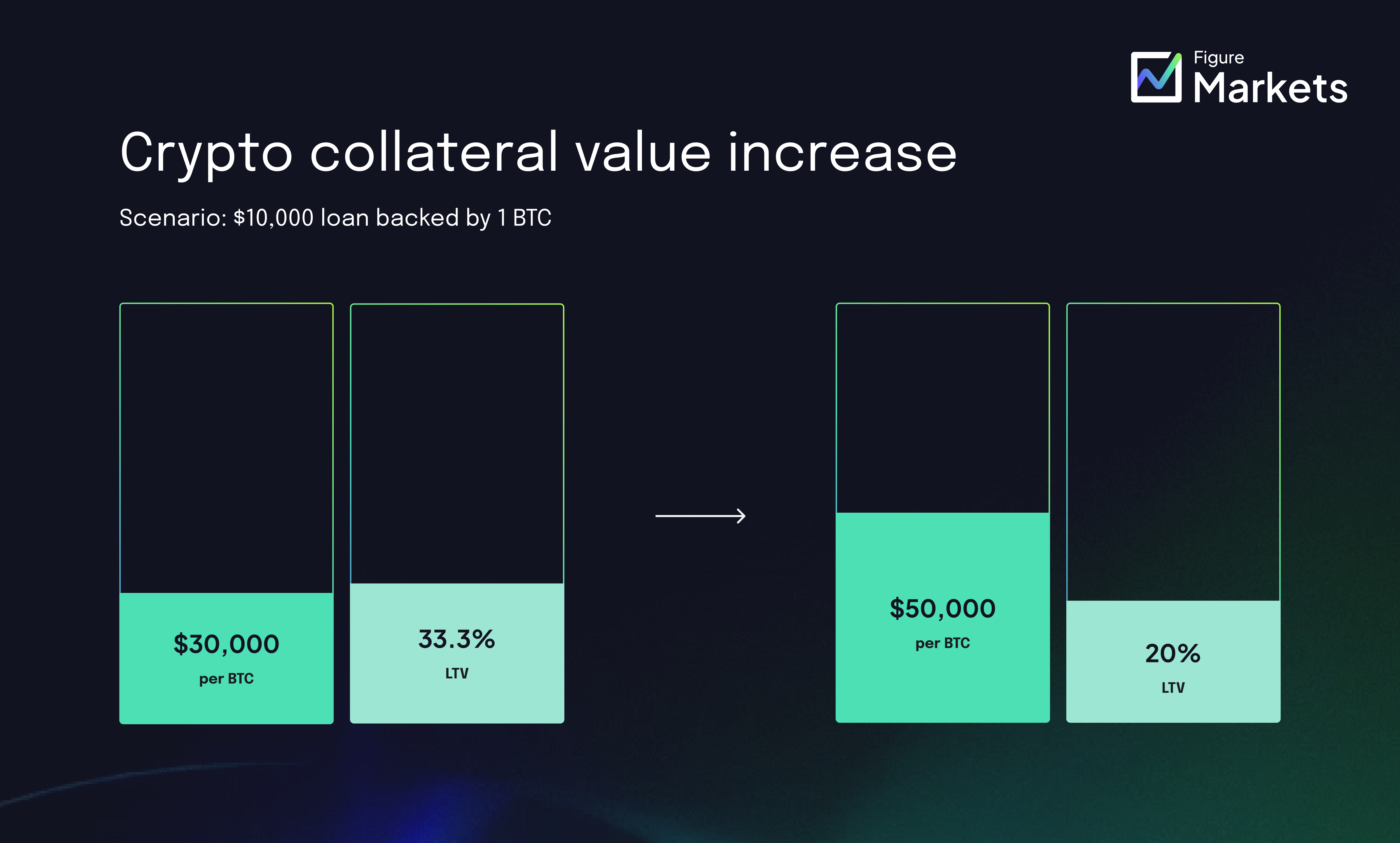
A decrease in the LTV ratio indicates lower risk for the lender because the collateral is now worth more relative to the loan amount. This increased security reduces the likelihood of a margin call or the need for additional collateral. Additionally, you may be eligible to borrow more funds against the increased value of your Bitcoin collateral.
What are the U.S. federal tax implications of taking out a crypto-backed loan?
When considering taking out a crypto-backed loan in the United States, it's important to understand the potential tax implications. Here’s a breakdown of key considerations. This is not tax, legal, or investment advice, and applicable tax rules and guidance are subject to change, please consult with tax professional:
Receiving the loan
Generally, receiving proceeds from a loan, including a crypto-backed loan, is not considered a taxable event. You do not incur a tax liability on the loan amount received when you open the loan.
Interest payments
Interest payments on a crypto-backed loan may or may not be deductible. If the loan is used for investment purposes, the interest may qualify as a deductible expense. However, if the loan is used for personal purposes, the interest is typically not deductible.
Collateral liquidation
- If your collateral is liquidated to repay the loan, this triggers a taxable event. You may owe capital gains tax if the value of the cryptocurrency has increased since your purchase date. The gain is generally calculated based on the difference between the sale price of an asset and its cost basis (generally, the original purchase price plus acquisition costs).
- The tax rate depends on how long you held the asset before it was liquidated. If held for more than a year, the gain may qualify for long-term capital gains rates, which are generally lower than short-term rates.
Loan repayment
Repaying the principal amount of the loan using cash (i.e., fiat) is generally not a taxable event.
Reporting requirements
Any gains from the liquidation of collateral must be reported on your tax return.
Whether you need cash to cover unexpected expenses, for an investment opportunity, or to diversify your portfolio, a crypto-backed loan can provide the financial flexibility you need while keeping your crypto holdings intact.
Crypto-backed loans often come with lower interest rates compared to traditional unsecured loans, and they typically don’t require credit checks.
Thinking of getting a crypto-backed loan? Apply today at Figure Markets!
Related Resources
Markets | Insights
Political Shifts, FTX & CFTC Settlement, and Block’s ASIC Breakthrough. All You Need to Know.
Continue reading
Markets | Insights
Bitcoin, AI, and Housing - The Unexpected Connections You Need to Know
Continue reading
Markets | Insights
Figure Markets on Markets - volume 1
Continue reading